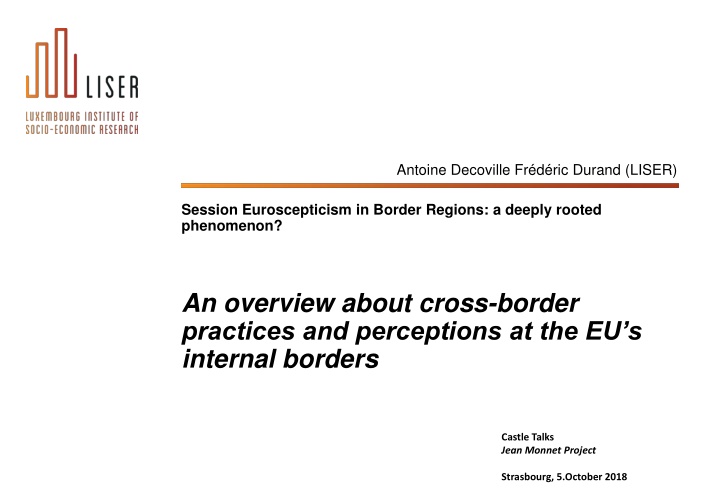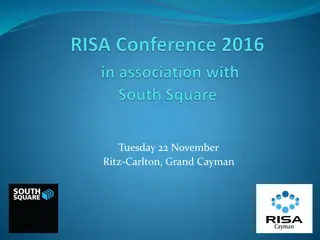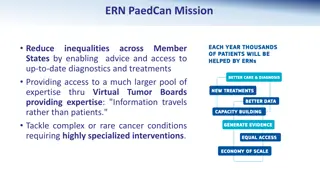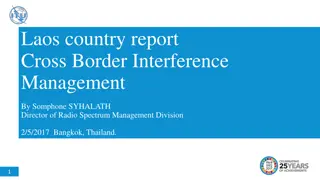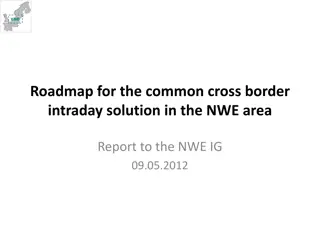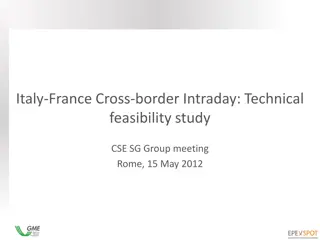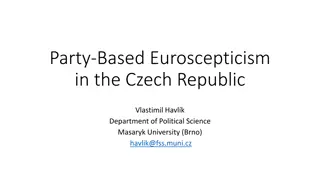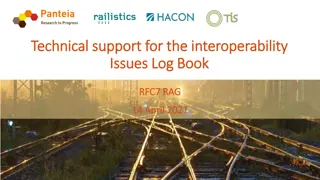Euroscepticism in Border Regions: A Deep Dive into Cross-Border Practices and Perceptions
Explore the phenomenon of Euroscepticism in border regions, delving into cross-border practices and perceptions at the EU's internal borders. This study sheds light on how border regions emerge both functionally and institutionally, emphasizing the importance of understanding Euroscepticism in these areas. Discover insights from literature on Euroscepticism in European border regions, examining utilitarian and identity arguments surrounding interactions across borders.
Download Presentation

Please find below an Image/Link to download the presentation.
The content on the website is provided AS IS for your information and personal use only. It may not be sold, licensed, or shared on other websites without obtaining consent from the author.If you encounter any issues during the download, it is possible that the publisher has removed the file from their server.
You are allowed to download the files provided on this website for personal or commercial use, subject to the condition that they are used lawfully. All files are the property of their respective owners.
The content on the website is provided AS IS for your information and personal use only. It may not be sold, licensed, or shared on other websites without obtaining consent from the author.
E N D
Presentation Transcript
Antoine Decoville Frdric Durand (LISER) Session Euroscepticism in Border Regions: a deeply rooted phenomenon? An overview about cross-border practices and perceptions at the EU s internal borders Castle Talks Jean Monnet Project Strasbourg, 5.October 2018
Background Focus on Cross-Border regions, CB planning and territorial strategies at a CB scale. How do CB regions emerge both in functional and institutional terms ? Definition used here to describe Euroscepticism: An opposition to the powers of the EU and to the idea of a European integration (Brack and Startin, 2015).
Introduction Why is it relevant to study Euroscepticism in border regions ? People who live in border regions are a priori very much concerned by the EU project and by one of its most tangible achievement: the dismantling of its internal borders. Border regions are privileged spaces for taking the pulse of the public opinion with regard to the European integration and the Europeanisation process.
Why study CB practices and perceptions? The purpose of Cross-border cooperation in the EU : to overcome national frontiers in order to heal the scars of history (A.Mozer, quoted by B. Wassenberg and B. Reitel, 2015). It should serve the European integration. Since the European community of steel and coal, the paradigm has been to create economic relations that are so strong that they discourage any country from engaging in a new conflict. But, there is a need to compare economic approach to CBI with the perceptions and social representations that people have of those living on the other side of the border need for a more qualitative approach of cross-border integration.
What does the literature say about Euroscepticism in European border regions ? Some (quite old) studies have shown that the inhabitants of border regions tend to be less Eurosceptic than the inhabitants of more central regions (Schmidberger, 1997; D ez Medrano, 2003;), although these findings are discussed and partially questioned for certain territories (Kuhn, 2011, Lubbers, 2007). Why ?
What does the literature say about Euroscepticism in European border regions ? The utilitarian argument (Kuhn, 2011): Goal oriented interactions beyond borders generate material benefits (Roose, 2010) satisfaction, greater adhesion to the EU project. The identity argument (Kuhn, idem) People living close to intra-European borders have greater opportunities to engage in transnational interactions than the rest of the population (Rippl and al. 2010, Roose, 2010). mutual understanding, tolerance adhesion to the EU project. living in a border region might affect transnationalism, which in itself leads to less Euroscepticism (McLaren 2006, 98)
What does the literature say about Euroscepticism in European border regions ? BUT, some other factors are likely to increase euroscepticism in border regions A distinction has to be made between the winners and the losers of the CBI process Ex. of winners : CB workers, some shopkeepers, Ex. of losers : non CB workers who have to face the rise of property prices due to the numerous CB workers with high incomes (Diop 2011), business who face the unequal competition of their neighbours , due for instance to tax differentials (Spierings and Van der Velde, 2008, Ohsawa, 1999 ) If the opening of borders creates new opportunities for some residents, others do not benefit from them or even have the feeling to suffer from it.
Methodology used to analyse CB practices and perceptions Analysis based on the results of the 2015 Eurobarometer 422 survey Cross-border cooperation in the EU (123 border regions covered by the 54 Interreg programs, 40,619 people interviewed) Creation of two indicators the functional dimension: how often do you go abroad to other countries? [ to carry out an activity ] ? The ideational dimension: Would you personally feel comfortable or uncomfortable about having a citizen from [neighbouring foreign region] as (i) your manager, (ii) your work colleague, (iii) your neighbour, (iv) a family member '. It shows the level of social mutual trust Mapping of the two indicators at the Nuts 3 level
Cross-border activities in European border regions 53.2 % of interviewees cross the border at least once a year 5.5 cross-border activities on average (min= 0.15. max= 18.2) Border crossings seem to depend on : The ease with which the border can be crossed The cultural proximity The incentives (price differentials, touristic attractions, wages differentials)
Mutual social trust between borderland neighbours Mutual social trust 85% of the people have a "comfortable feeling" with having someone coming from the neighboring region as a manager, a work colleague, a neighbor or a family member, but results vary a lot. Eastern and South eastern Europe present rather low levels of trust in the foreign neighbour. No strong correlation (r =0.35) between the intensity of CB flows and the level of trust
Focus on the Swiss case-study: Switzerland, (non EU member but member of the Schengen area) shows a very strong functional integration (most important number of CB workers in Europe) and, on the same time, quite hostile behaviors towards neighbouring populations. Mouvement Citoyen Genevois in Geneva against CB workers In Ticino, approval by a vote of the Prima I Nostri initiative in favour of the national priority in new recruitments (2016).
Challenges for European integration The comparison of the two maps as well as the Swiss case-study question one of the most important postulates that shape the EU territorial cooperation policy More flows does not necessarily mean a better quality of cross-border relationships
The importance of national related factors CB practices and perceptions are similar for the Border regions of each country of residence. They seem to depend more on the national context than on who the neighbours are. Are perceptions shaped by national discourses ?
Other findings The richer the people, the more they tend to cross borders (r =0,38). The richer the people, the more they tend to have trust in their foreign neighbours. (r =0.49). The level of trust is lower in countries that have recently joined the EU, but the opposite is not always true! It takes time to build relationships of trust, but time alone is not a sufficient criterion to achieve a high level of mutual social trust. Correlation is no causality !
Conclusion After 25 year of dismantling, border practices have boomed, but with contrasted effects on peoples perceptions. The invisibilisation of borderlines has not erased the social, cultural and economic differences between borderland societies. In a context in which borders are coming back to the forefront in populist discourses, the policy focus should be on improving the quality of CBI more than just the intensity of flows.
References Brack, N., and N. Startin. (2015). Introduction: Euroscepticism, from the margins to the mainstream. International Political Science Review 36 (3):239 49. Decoville, A. & Durand, F. (2018). Exploring cross-border integration in Europe: How do populations cross borders and perceive their neighbours?, European Urban and Regional Studies. Durand F, Decoville A and Knippschild R (2017) Everything all right at the internal EU borders? The ambivalent effects of cross-border integration and the rise of Euroscepticism. Geopolitics. D ez Medrano, J. (2003). Framing Europe. Princeton, NJ: Princeton University Press. Diop, L. (2011). M tropolisation transfrontali re et sp cialisation sociale Luxembourg La concentration spatiale des actifs m tropolitains sup rieurs. L Espace G ographique 40 (4):289 304. Kuhn T (2011) Europa ante portas: border residence, transnational interaction and Euroscepticism in Germany and France. European Union Politics 13(1): 94 117. Ohsawa Y (1999) Cross-border shopping and commodity tax competition among governments. Regional Science and Urban Economics 29(1): 33 51. Rippl S , B cker N and Petrat A (2010) Crossing the frontier: Transnational social integration in the EU s border regions. International Journal of Comparative Sociology 51(1 2):5 31. Roose J (2010) Vergesellschaftung an Europas Binnengrenzen. Eine vergleichende Studie zu den Bedingungen sozialer Integration. Wiesbaden: VS Verlag f r Sozialwissenschaften. Schmidberger, M. (1997). Regionen und europ ische Legitimit t. Der Einfluss des regionalen Umfeldes auf Bev lkerungseinstellungen zur EU. Frankfurt, Germany: Peter Lang. Spierings B and Van der Velde M (2008) Shopping, borders and unfamiliarity: consumer mobility in Europe. Tijdschrift voor Economische en Sociale Geografie 99(4): 497 505.
